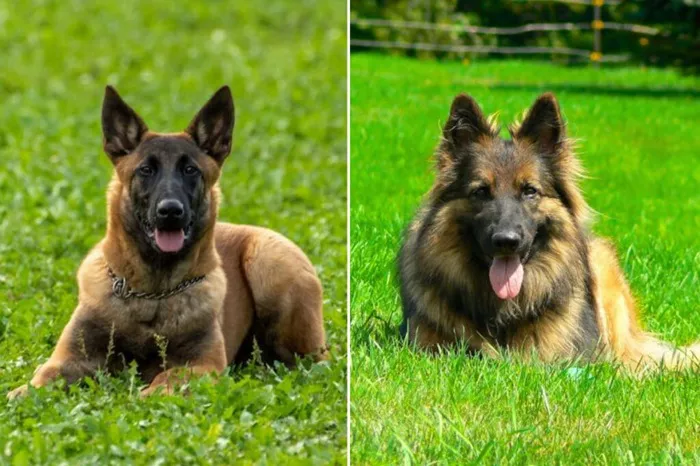German Shepherds (GSDs) and Belgian Malinois (Mals) are two of the most recognizable working dog breeds globally, often mistaken for each other due to their similar appearances. However, their differences in temperament, physical traits, and suitability for specific roles make them distinct. This article breaks down these differences to help potential owners, trainers, or enthusiasts understand which breed aligns with their needs.
Breed Origins and Historical Roles
German Shepherd
Developed in Germany in the late 19th century, German Shepherds were initially bred for herding sheep. Their intelligence and versatility soon made them indispensable in military, police, and search-and-rescue roles. Today, they are also popular as service dogs and family companions.
Belgian Malinois
The Malinois is one of four Belgian Shepherd varieties, originating in the city of Malines, Belgium. Bred for herding and guarding livestock, their agility and focus later earned them prominence in military and law enforcement roles, such as bomb detection and special operations.
Key Insight:
While both breeds excel in working roles, Malinois are often preferred for high-intensity tasks, whereas GSDs are more common in family and therapy settings.
Physical Characteristics
Size and Build
German Shepherd: Males weigh 65–90 lbs (29–41 kg) and stand 24–26 inches tall. They have a robust, slightly elongated body with a dense double coat.
Belgian Malinois: Slightly leaner, males weigh 55–75 lbs (25–34 kg) and stand 24–26 inches tall. Their shorter, weather-resistant coat emphasizes agility.
Coat and Grooming
GSDs: Thick double coat sheds heavily year-round, requiring brushing 2–3 times weekly to prevent matting.
Malinois: Shorter coat sheds moderately; weekly brushing suffices. Bathing every 4–6 weeks is typical unless they engage in muddy activities.
Visual Difference:
Malinois have a fawn or mahogany coat with a black “mask,” while GSDs are often tan with a black saddle.
Temperament and Energy Levels
German Shepherd
Temperament: Loyal, confident, and calm. They bond deeply with families and are gentle with children when socialized early.
Energy: Require 1–2 hours of daily exercise. Enjoy structured tasks like obedience training or hiking.
Belgian Malinois
Temperament: High-drive, intense, and sensitive. They thrive on constant activity and form strong bonds with a single handler.
Energy: Need 2+ hours of vigorous exercise (e.g., agility drills, running). Without stimulation, they may develop destructive habits like chewing or digging.
Key Contrast:
Malinois are more “work-focused” and less tolerant of downtime, while GSDs adapt better to relaxed family environments.
Trainability and Working Roles
Training Style
GSDs: Highly trainable and forgiving of mistakes. They aim to please, making them suitable for first-time handlers.
Malinois: Quick learners but demand experienced trainers. Their sensitivity to criticism requires positive reinforcement methods.
Common Roles
GSDs: Search-and-rescue, therapy work, and family protection.
Malinois: Military operations, police K-9 units, and competitive dog sports like Schutzhund.
Performance Data:
A 2023 study comparing working dogs found Malinois scored higher in precision tasks (e.g., scent detection), while GSDs excelled in adaptability to changing environments.
Health and Lifespan
Common Health Issues
GSDs: Prone to hip dysplasia, degenerative myelopathy, and bloat. Lifespan: 9–13 years.
Malinois: Generally healthier but may develop elbow dysplasia. Lifespan: 12–15 years.
Preventive Care
Both breeds benefit from:
- Regular joint supplements (e.g., glucosamine).
- Controlled diets to prevent obesity.
Suitability for Different Lifestyles
Family Life
- GSDs: Adapt well to homes with children. Their protective nature makes them excellent guardians.
- Malinois: Best for active households without young kids. Their herding instincts may lead to nipping.
Living Space
GSDs: Can adapt to apartments if exercised sufficiently.
Malinois: Require large yards or rural settings to burn energy.
Owner Experience
Malinois: Not ideal for novice owners. Their intensity can overwhelm those unfamiliar with working breeds.
GSDs: More forgiving; suitable for dedicated first-time owners.
Legal and Social Considerations
In regions like Changzhou, China, both breeds are classified as “restricted” due to their protective instincts. Owners may need permits or face housing restrictions.
Cost and Adoption
Puppy Prices
GSDs: 3,000 from reputable breeders.
Malinois: 4,000, with working-line dogs costing more.
Adoption Challenges
Shelters often see surrendered Malinois due to owners underestimating their needs. GSDs are more commonly available in rescues.
Case Studies
Case 1: Military Malinois
A Malinois named Koda served in a U.S. Navy SEAL team, specializing in nighttime operations. His agility and focus outperformed GSDs in high-stakes missions.
Case 2: Therapy GSD
A German Shepherd named Luna transitioned from police work to therapy, comforting trauma survivors. Her calm demeanor highlighted the breed’s versatility.
Conclusion
Choosing between a German Shepherd and Belgian Malinois hinges on lifestyle, experience, and goals:
- Choose a GSD for a loyal family companion or versatile working dog.
- Choose a Malinois for high-performance tasks requiring speed and precision.
Both breeds demand commitment but reward owners with unmatched loyalty and capability. Always prioritize their physical and mental needs to ensure a fulfilling partnership.
Related Topics:
HOW MUCH DO AIREDALE PUPPIES COST?
WHEN DO BICHON PUPPIES STOP GROWING?
WHAT IS A BEARDED COLLIE MIXED WITH?


